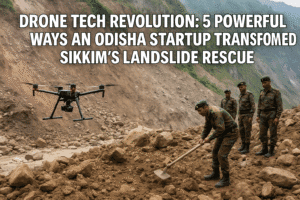Drone Tech Revolution: 5 Powerful Ways an Odisha Startup Transformed Sikkim’s Landslide Rescue
Odisha startup BonV Aero deployed pioneering drone technology to aid Indian Army rescue efforts following catastrophic landslides in Lachen, Sikkim. Their specialized UAV, equipped with ground-penetrating radar and AI analysis, safely scanned unstable debris fields from the air—overcoming risks of traditional ground searches. Within 24 hours, the drone pinpointed two critical subsurface anomalies at precise depths (0.76m and 0.015m), later confirmed as human remains.
This real-time data guided recovery teams with unprecedented accuracy, enabling targeted efforts without endangering personnel. The mission proved vital in locating soldiers buried under treacherous Himalayan terrain, providing swift closure. BonV Aero’s innovation signifies a transformative shift toward safer, faster disaster response by seeing beneath hazardous surfaces without physical disturbance. This demonstrates how Indian deep-tech can deliver life-saving precision where conventional methods falter.

Drone Tech Revolution: 5 Powerful Ways an Odisha Startup Transformed Sikkim’s Landslide Rescue
The Himalayan town of Lachen, Sikkim, became a scene of tragedy last month as catastrophic monsoon landslides tore through the landscape. Among the devastation, three soldiers lost their lives, and six remained missing, buried under tons of unstable debris in one of the world’s most treacherous terrains. In the frantic search that followed, amidst the limitations of traditional methods, an unexpected hero emerged from Bhubaneswar, Odisha: BonV Aero and its groundbreaking drone technology.
The Challenge: A Race Against Time on Unstable Ground
Searching through landslide debris is perilous. Unstable mounds can shift catastrophically, endangering rescue teams. Traditional methods – manual digging, sniffer dogs, and ground-penetrating radar (GPR) dragged across the surface – are slow, risky, and often imprecise in such chaotic environments. Time was critical, and the unstable Himalayan slopes near Lachen demanded a safer, smarter approach.
The Innovation Takes Flight: Seeing Beneath the Surface from the Sky
Within 24 hours of the disaster, BonV Aero, a deep-tech startup, deployed its specialized UAV platform equipped with Ground Penetrating Radar (GPR). This wasn’t just any drone. Its core innovation lies in integrating advanced GPR sensors with real-time imaging and AI-powered anomaly detection software, all mounted on an aerial platform capable of navigating the challenging Himalayan terrain.
While ground-based GPR requires personnel to traverse dangerous, shifting ground, BonV Aero’s drone hovered safely above, scanning vast areas of the debris field without adding weight or disturbance to the fragile slope. The GPR pulses penetrated the subsurface, searching for anomalies indicating buried objects or voids. Crucially, the onboard AI processed this complex data in real-time, transforming raw signals into actionable insights for the rescue teams on the ground.
Precision in the Midst of Chaos: The Breakthrough
The technology delivered decisively. BonV Aero’s drone identified two critical subsurface anomalies at specific locations. The data provided precise coordinates and depths: one reading at 0.76 meters and another at a remarkably shallow 0.015 meters (just 1.5 cm) beneath the surface. Guided by this unprecedented precision, Indian Army recovery teams were able to focus their efforts with minimal risk. Both locations were confirmed to contain human remains, bringing crucial, albeit sorrowful, closure in the search for the missing soldiers.
Beyond the Immediate Rescue: A Paradigm Shift in Disaster Response
The significance of BonV Aero’s contribution extends far beyond this single mission:
- Enhanced Safety: “What differentiates our system,” explained CTO Abinash Sahoo, “is its ability to safely see beneath unstable land and transmit actionable data without risking more lives.” Removing personnel from direct danger on unstable debris fields is a game-changer.
- Unprecedented Speed & Coverage: Aerial deployment allows rapid scanning of large, inaccessible areas, drastically reducing the time needed to locate victims compared to painstaking manual searches.
- Pinpoint Accuracy: Providing precise coordinates and depths transforms rescue from guesswork to targeted action, maximizing the effectiveness of recovery efforts and preserving dignity for the victims and their families.
- Preserving the Scene: Unlike heavy machinery or extensive digging, the non-contact scanning minimizes disturbance to the debris, maintaining vital evidence and reducing secondary collapse risks.
A Beacon of Indian Innovation:
CEO Satyabrata Satapathy’s pride is palpable: “With this technology, India can now approach landslide rescue and disaster response with smarter, faster, and safer methods.” The Lachen mission starkly illustrates this potential. Born in Odisha, BonV Aero’s technology tackled a Himalayan disaster, demonstrating how homegrown Indian innovation can directly address critical national challenges.
The Human Impact, Amplified by Technology
While the loss of life in Sikkim remains a profound tragedy, BonV Aero’s intervention highlights a vital shift. It showcases how technology, thoughtfully applied, can bring precision and humanity to the most desperate situations. By enabling the swift and safe location of victims buried under meters of unstable earth, this Odisha startup hasn’t just provided a tool; it has offered a measure of solace through certainty, proving that even in the face of nature’s fury, human ingenuity can illuminate the darkest depths. Their drones represent more than advanced engineering; they signify hope, efficiency, and a safer future for disaster response across India’s vulnerable landscapes.
You must be logged in to post a comment.